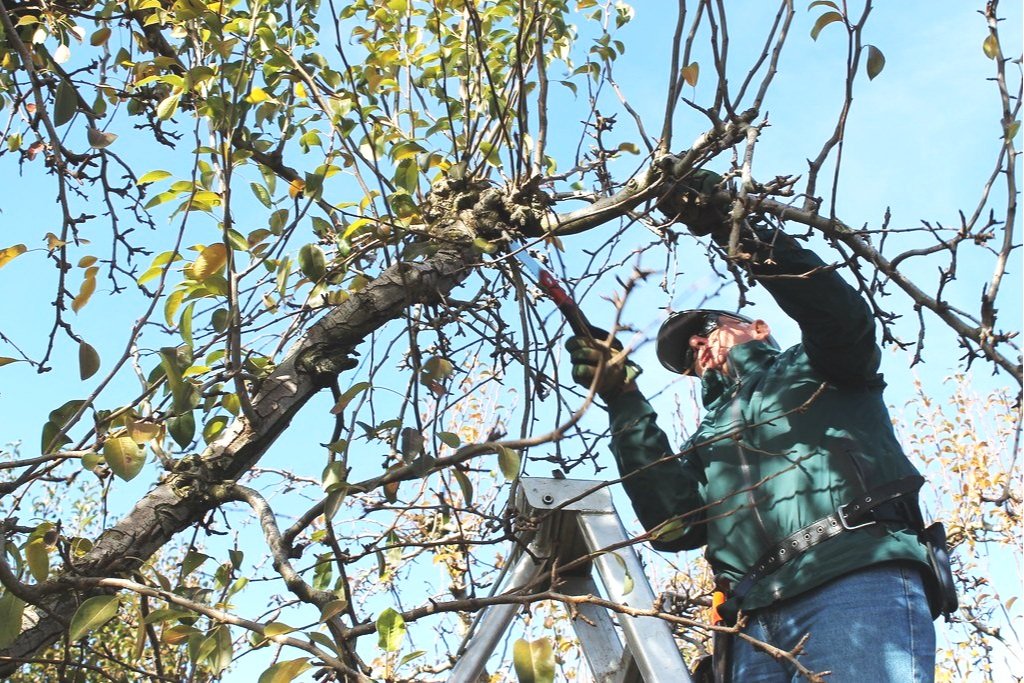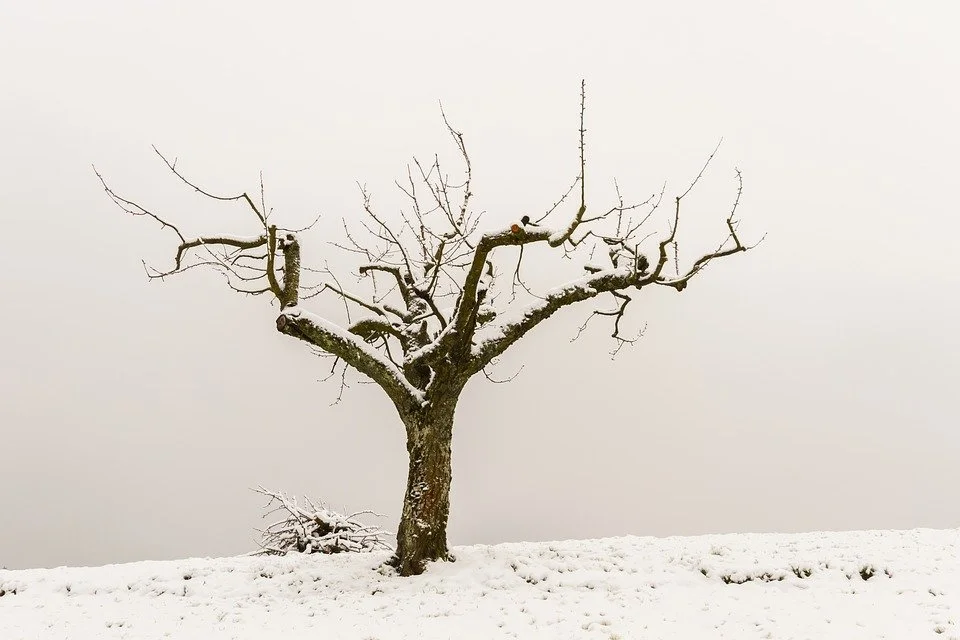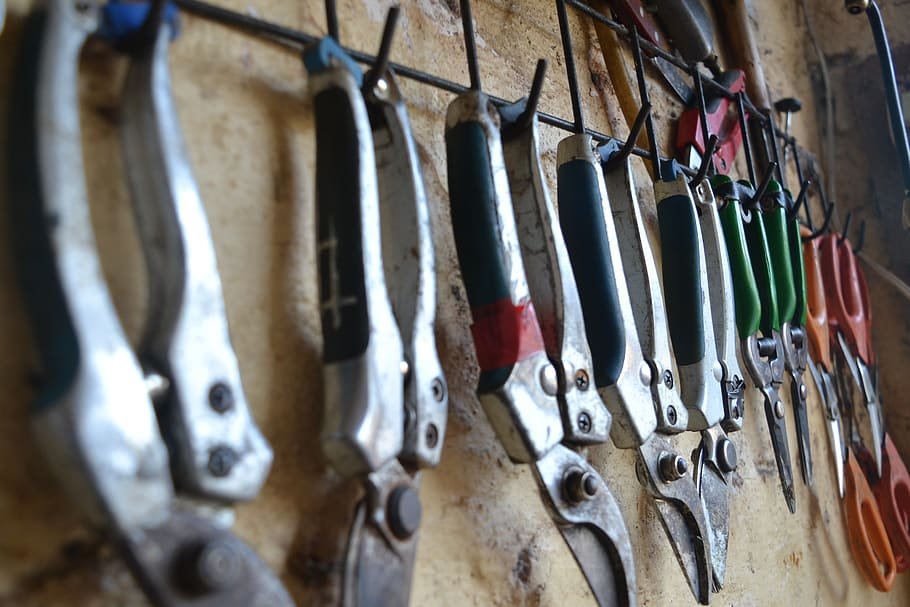Winter (& early spring) Pruning For Fruit Trees
Welcome back to another landscaping season! We’ve taken a rest from the content creation before hitting the ground running at the beginning of this spring season. Before we find ourselves falling into those May Flowers, we have to take the opportunity to talk about one of the groups of plants we prune this time of year: fruit trees.
Pruning is one of the most intimidating horticultural methods for homeowners and beginning horticulturalists. We get it, it’s high risk! Once you make the cut, you can’t put it back. The good news is that, in most cases, you will not hurt the plant permanently. The bad news? You may end up sacrificing blooms, fruit production, structural shape, and aesthetic beauty if pruning is not done correctly or at the right time of year. Here are a few of the foundational items to take into consideration when starting a pruning job, and we will link you to some of our favorite pruning how-to guides and informational resources at the end!
Know Your Plants: When Is The Right Time?
Each specific plant and variety has a set of unique needs, including what time of year is best to prune.
Pruning fruit trees is best done in the late winter or very early spring when the trees are still dormant but after the coldest weather has passed. An unexpected cold snap could cause damage by prolonging the wound’s exposure to elements that could threaten its health. Waiting until these risks are reduced allows the plant’s wounds to heal from the pruning cuts.
Your next task is to identify the plant you are going to prune. Knowing the species and cultivar of the plant also helps to guide you towards determining the shape you will be working with, as each variety of plant has a natural growth habit. Pruning should enhance and encourage the shape in which the plant is genetically programmed to grow. Otherwise, you’ll find yourself in a constant fight with a shrub or tree full of stubborn cowlicks. It may help to keep an image of the shape nearby for reference, and always remember to stop frequently to take a step back and look at the big picture, this is the best way to ensure that you are on track to making the right cuts to bring your plant down to the proper shape.
Right Tools For The Job
Having the proper tools is helpful for successful pruning. Hand pruners, loppers, handsaw, and pole pruners may be needed depending on the size of the plant. If you are tackling a larger shrub or tree, you may need a ladder. If you do, be sure to carefully follow ladder safety and have someone spot you or be nearby in case there’s an accident.
When you’re getting this up-close-and-personal with a plant, you’re likely to be subject to the pointy end of a twig invading your personal space. Gloves, long-sleeves, and pants may offer your skin added protection, and safety glasses are a must--trust me on this one, a stick in the eye is NEVER fun! Safety glasses bear with them the added bonus of protection wind-blown sawdust swept up into your face while you are in the middle of making a cut.
Quick Tool Tips!
Always sanitize your tools with alcohol to reduce the spread of disease and pests.
Regular tool maintenance can make the tools work for you. Sharpen your tools regularly not only achieves smoother, cleaner cuts for a healthy plant, but it also reduces the strain on your body, especially your hands and wrists.
Making The Cut
Once you’re geared up, it’s time to assess your tree. When determining where to begin, look for dead and broken branches first. In the wild, Mother Nature will take charge of the pruning with wind- and ice storms that knock out the weakened branches. This can sometimes cause additional damage as the branch rips from the rest of the trunk or other branches. A clean, well-made cut can be a great way to prevent unnecessary damage to a tree.
Next, any rubbing or crisscrossed branches should come out. With fruit trees especially, you want branches that are strong to carry the load of the fruit. These branches will grow larger, competing for the same space and resources. The leaves on one branch may shade out those on the other, or the branches may grow closer together until they are pushing or rubbing on each other. That pressure and friction can damage the delicate cambium, which lies just beneath the bark and is the part of a plant’s internal cell structure that is responsible for transporting nutrients throughout the entire plant! While you’re looking for those patterns, see if any branches are growing inwards, towards the trunk of the tree.
Those should be removed to prevent them from intersecting with other branches in the future and to create space between the branches. Thinning is a good practice so that the remaining branches get equal amounts of airflow, sunlight, and rain. This reduces the chances of disease and is beneficial for fruit ripening.
Shaping / Dwarfing The Plant
Finally, shaping or dwarfing the plant is done. Sometimes the plant is starting to grow into the home or out into a walkway. Perhaps the full size of the mature plant was not taken into account at the time it was planted, but you do not want to remove or replace it. In the case of fruit trees like apples, cherries, pears, and plums, you’ll want to select a dominant branch (the central leader) and form a pyramidal shape in the crown of the tree (the top). If you are pruning apricots, cherries, crabapples, nectarines, peaches, plums, or quince, you may leave the center open.
In Conclusion
Pruning promotes new growth--hormones are stimulated when live branches are cut that then send signals to the surrounding buds to activate. What better time to stimulate new growth than at the beginning of the growing season? The flower buds haven’t formed yet so you aren’t sacrificing any fruit, and the energy that would have gone into the branches that have been pruned can now be redirected towards more, dare we say, fruitful efforts. Now is the time to get ahead of mother nature, at least when it comes to some plants, like those fruit trees of yours.
Certainly, we can help with your pruning needs, as there are specific ways the cuts should be made and could fill another blog article (or ten!). If you’d like help pruning your fruit trees, email Leigh Lessard at leigh@sitestructureslandscape.com or call 207-475-8834.
Want To Learn More?
Check out two of our favorite pruning books that are both informative and easy to read!
The Pruning Answer Book by Lewis Hill & Penelope O’Sullivan
The Pruning Book by Lee Reich
Thanks for reading, we’ll see you next time!
This article was written by Leigh Lessard, Director of Landscape Maintenance with editing, and publishing help from Daisy Chinburg, Landscape Designer.
Questions?
Give us a call* at (207) 438-9995 or visit our contact us page here on our website and ask for us to get in touch with you. Don’t forget to mention reading this blog!
*If you are a current customer we ask that you please contact your regular project manager as our office staff is currently loaded with work and may not be able to get back to you as quickly as we’d all like. Thanks in advance!




